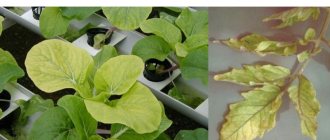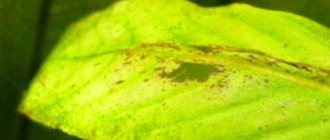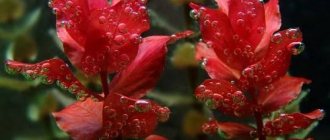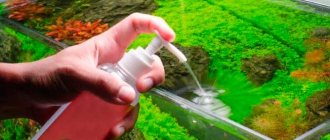4.6
(22)
Plants play an important role in modern aquarium keeping. They are present in almost every aquarium (except those that keep cichlids or marine life forms). This is really a necessity, because they:
- They are one of the best ways to decorate an aquarium;
- Help set up and maintain biological balance;
- Serve as a shelter for some fish, as well as fry;
- They are an effective natural filter because they process waste products of fish and other aquarium inhabitants;
- They can be an additional diet for underwater pets, and some types of fish even need to eat plants for normal intestinal function.
However, underwater flora can only be beneficial and decorate the aquarium if it itself is healthy. With improper care and maintenance conditions, plants can quickly die, and after them, problems with animals will begin. Therefore, to avoid such troubles, you need to carefully monitor them.
Yellow spots appear on the surface of the leaves, the edges begin to fade
This indicates a lack of potassium. Every plant needs it because it is a catalyst for growth. In aquarium conditions, it does not get into the water with changes. Therefore, if you do not add it, the problem will definitely remind you of itself. But her solution is quite simple. It is enough to purchase fertilizer at the pet store, namely potassium monosolution. It is often applied weekly, after changes.
If there is no desire or opportunity to buy parole, then you can prepare it yourself. To do this, you need distilled water and a solution of potassium sulfate. It is mixed with the distillate and boiled. After brewing a little, the homemade fertilizer can be considered ready.
Lack of microelements
Microelements. These are boron, zinc, copper, manganese, molybdenum, cobalt.
Signs of boron deficiency are blackening and death of the apical growing points. The lack of boron in aquarium water can be compensated by adding boric acid or borax (0.2 mg per 1 liter of aquarium volume).
The lack of zinc can be compensated by adding zinc sulfate, which is added in an amount of 0.1 mg per 1 liter of water.
If there is a lack of copper in the water of the aquarium, the entire leaf blade turns pale, and the soft tissues of the leaf die. Copper can be added to the aquarium in the form of copper sulfate (0.2 mg per 1 liter of water).
Manganese deficiency manifests itself in the appearance of small, first light, and then brown spots between the veins of young leaves.
Most macro- and microelements are contained in complex mineral fertilizers. It is necessary to fertilize with mineral fertilizers periodically. This is best done with regular water changes once a week or every ten days. Fertilizers are added to the water being changed, the volume of which is usually 1/5-1/4 of the volume of the aquarium.
Cryptocoryne disease
One of the most serious illnesses. It manifests itself in the fact that holes form on the leaves, and soon they completely decompose in the water along with the stem. It is impossible to cure it, since it is not known what the root cause is. All the aquarist can do is trim off the affected leaves and perform a water change. If the root remains intact, the bush will recover after some time.
Effect of light and temperature
In low light, plants become pale in color and lose their lower leaves. They try to get closer to the light, their internodes stretch out, their stems become thinner, and they shed their leaves at the bottom. In this case, you need to see if other plants in the aquarium are taking up too much light, and thin them out if necessary. You can also make the lighting more powerful.
If your plants have unusually small leaves, it means they are not getting enough light and need feeding. If the red part of the spectrum of the lighting lamp is too powerful, the upper parts of the leaves may become elongated.
Don't forget that the higher the temperature in the aquarium, the more lighting it needs. If the ratio of light and water temperature is disturbed, plants develop long internodes and small leaves.
Water temperature plays a huge role. Just like fish, when the temperature drops, the plant can “freeze” and die. At elevated temperatures, all processes in the plant body are accelerated and require an influx of significantly greater amounts of nutrients, including carbon dioxide, which, in turn, increases the need for brightness of lighting for the processes of photosynthesis.
The leaves turn yellow, but the veins remain green
There may be two reasons. The first is a lack of manganese, the second is an excess of iron. In the first case, you can simply add more elements, and here you only need to choose the optimal parole composition. In the latter, you just need to reduce the dosage of iron or trace elements that may contain it.
Aphid
Floating plants, such as pistia or water hyacinth, can harbor aphids and feed on their sap. To quickly get rid of it, you need to transplant the affected samples into a jar of water. Prepare a solution separately: 1 liter of water, 1 g of copper sulfate, 20 g of green soap. And spray the surface with this solution. There is another way: pour 1 teaspoon of garlic peel with a glass of boiling water and leave for 3 days.
Take care of your plants by regularly changing the water and cleaning the soil. Maintain biological balance. Apply fertilizers and fertilizers containing a full range of essential micro- and macroelements. By creating conditions close to natural, you thereby ensure their normal growth, development and reproduction.
Quick diagnosis of aquarium plant diseases
Below is a summary table of problems and their possible causes that we may encounter when growing aquarium plants.
| problem | cause | comments |
| Inhibition of plant growth (short and thin shoots, growing and weak plant) |
| — improve water circulation in the aquarium; |
| Plant gnome (whole) |
| |
| Inhibiting the growth of floating plants |
| |
| Elongated, thin shoots and leaf blades (the plant grows not to the side, but in height) |
| |
| Rotting edges of leaves and stems, shedding leaves, dying |
| |
| Necrosis (necrosis) - death of plant cells and tissues |
| — necrosis appears initially on new leaves; - necrosis first appears on old leaves; - the supplied part of the water; |
| White-gray limescale on plant leaves |
| - Some plant species (for example, dips, urea or Echinodorus) have the ability to assimilate carbon dioxide from calcium bicarbonate. A by-product of this process is the production of water-insoluble calcium carbonate, which is deposited on plant leaves. |
| Chlorosis (disappearance of chlorophyll in plants) - gradual disappearance of the plaque until it turns yellow |
| - more noticeable on old leaves than on new ones, leaves do not fall; - visible on old leaves; - first on young leaves; - the spots are sometimes brown; - new leaves; - if Mo oxychloride deficiency occurs at a later stage; |
| Yellowing of plant leaves, green innervation |
| - first on young leaves; - first on old leaves; - old leaves; |
| Change in leaf color to bluish-green |
| - old leaves; |
| Darker plaque color, purplish-red underneath |
| |
| Leaf coloring red (in some species) |
| |
| red foliage leaves |
| |
| Brown spots on leaves |
| - water change; |
| Leaf deformation and stunted growth |
| - new leaves; - new leaves; |
| Curling of leaves at the edges |
| |
| Bitten leaves, evenly cut holes in the plate |
| |
| Falling old leaves |
| |
| Death of new leaves |
| |
| Reduced rate of development of new leaves and roots |
| |
| Rotting of plant roots |
| |
| The stem is broken |
| |
| Shorter internodes, smaller leaves |
| |
| Death of a Plant's Growth Cone |
| |
| New shoots turn yellow after a few days |
| |
| seaweed |
| |
| Plant nuisance |
|
ICHTHYOPHTHIRIOSIS IN FISH TREATMENT SYMPTOMS PHOTO VIDEO DESCRIPTION.
GUPPY DISEASES EXTERNAL SIGNS AND TREATMENT PHOTO DESCRIPTION VIDEO.
FIN ROT - DESCRIPTION TREATMENT SYMPTOMS VIDEO PHOTO.
DISEASES OF AQUARIUM FISH, CONTAGIOUS AND NON-CONTAGIOUS - TREATMENT DESCRIPTION PHOTO SYMPTOMS VIDEO.
Reason 8. Wrong food for aquarium fish
How can food affect aquarium plants? It’s very simple - it participates in the nitrogen cycle, and yes, plants don’t grow with cheap feed. At the beginning of our activities, we tried our feed production. Aquarium, 500 liters, 500 growing astronotuses. In wholesale trade there are always such pressures. We feed, after half an hour we can see 5 cm of water. Everything else is dregs. Even we tried to make food. It seemed that everything was simple, they mixed the ingredients, put it through the machine, and everything was fine. Even our food showed better growth results than ichthyovite flakes. But here’s the problem, after half a year the fish in the service (Malawians) began to get enough sleep - the ammonia level increased. We had to kill our business. And others are still in the way.
Additional recommendations
For the normal development of vegetation, perform the following actions:
- The fluid in the reservoir is replaced at certain intervals. Change 25-30 percent of the water every 7-10 days.
- Various types of vegetation are used to fill the container. The number of species depends on how large the reservoir is and what specific phenotypes are present in it.
- It is prohibited to introduce fish and shellfish into the container, which violate the integrity of the root system and leaves. After all, the plants will die quite quickly.
- Periodic monitoring of organic residues is required. An excess of these components causes algae and shady plants to rot and disappear.
- New representatives of the flora are planted after quarantine. The duration of quarantine is 14–21 days. If necessary, the duration of quarantine is increased.
Studying the main causes that lead to the death of vegetation allows us to timely identify the problem and also solve it. Before starting to solve any difficulties that have arisen, the optimal mode is established in the tank. This is necessary in order to restore the ecosystem in the aquarium.
Video on how to prevent the death of aquarium plants
AdminAuthor of the article
Did you like the article?
Share with your friends:
Prevention measures
Anyone who has ever encountered a black beard understands that it is better to prevent its appearance than to waste time and effort on removing it. Fortunately, a few simple rules of prevention will help with this:
- Keep the aquarium clean. It is necessary to do weekly water changes (1/4) and siphon sediment from the soil. The filter power should be enough for the volume of the aquarium.
- Thin out underwater vegetation. Dead parts of the plant are good “soil” for the propagation of compogonum. They must be removed from the tank immediately.
- Get herbivorous cleaner fish and snails. Particularly good are ancistrus, Siamese algae eaters, labeo, mollies, carp, and ampullaria.
It will be useful for beginners to read stories and advice from experienced colleagues. What methods of controlling black algae in an aquarium do you find most effective? Write your answers in the comments!
Reason 2. Conditions for plants are incorrectly selected
Each plant requires certain conditions. For example, Madagascar aponegeton does not grow without micro, glossostigma does not grow without CO2, and ambulia does not grow without light. Now, if you do not create conditions for plants, they will wither. less than 1% of herbalists supply CO2, less than 40% add fertilizers. In 10-20% of herbalists the light is terrible. You just need to choose plants that suit your parameters. I'm not even talking about the water you have, its hardness, acidity level. You can try “at random” to determine what is suitable. You can order a consultation. The main thing is that the person understands the topic. And there are no other options. The most interesting thing is that a knowledgeable person will most likely exclude some part of the plants that will definitely not grow, and will recommend finding out everything else “at random.”
Inappropriate lighting
Add light - this advice is often found on forms of aquarists.
And they even give standards - 1 W per liter of volume. This statement falls into the category of “bad advice.” The only thing you will get is a violent proliferation of algae, which in turn will further disturb the plants. Why is the formula 1 W/l. not working. It was invented by Takeshi Amano and told to someone at some time. The formula was simply cut out of context and began to be actively used. Amano said this about his 1.5 m high aquarium at the end of the last century. If we use the advice in our more modest-sized aquariums, we will not end up with a clean pond with fish, but a real swamp.
Light needs to be selected based on many related factors: type of vegetation, water quality, fish living in the aquarium. The emission spectrum is also important. Simply measuring illumination in watts for aquatic vegetation is not acceptable.
The reaction of plants to the intensity of lamps differs from the perception by the human eye. It seems to us that everything is wonderful and the water is very light, and the plants are “blind.” And vice versa, when there is enough green light, it seems to us that the water is too dark. We increase the amount of light and only make things worse.
Proper lighting is the key to high-quality plant growth
There is no unambiguous formula acceptable for any conditions. An ideal result can only be obtained experimentally. The indicator is the condition of the plants themselves. They react to a lack of light by slowing growth and forming small leaves. If the stems stretch and the distance from one internode to another increases, the problem is a lack of nutrition, possibly together with poor lighting.
Pay attention to cryptocarines, ferns, anubias. They produce normal new leaves even in poor light. If they are doing well but other species are suffering, start adding more lighting or changing the quality of it.
Photosynthesis processes normally occur under radiation of the orange-red or blue spectrum. Manufacturers rarely equip aquarium lamps with such lamps. More often they use lamps with a cool white or slightly bluish spectrum. We like it, but it is useless for plants.
If the lamp uses a lamp of the required spectrum, the reason for poor growth may lie in the fact that it has exhausted its service life. In this case, previously developing plants begin to wither. It seems to us that everything is in order with the lighting, but the plants already feel that the lamp has “shut down”. A reasonable solution in this case is to buy a new lamp.
How to choose lighting
The amount of light is professionally determined by a PA R-meter. But aquarists are unlikely to have this device. Therefore, you can use general recommendations. For example, T 8 has the shortest brightness along the length, and T 5 has 2 times more brightness. A compact lamp and LEDs give more light along the length, but are not efficient in spreading the light rays. Halogen lights shine well in deep aquariums (from 90 cm in height), but it is better not to use them in small ones.
T 5 lamps with reflectors are suitable for most plants. They are selected according to the length of the container. Most plants need 2 tubes. 4 T 5 lamps – intense lighting and not all plants need it.
Color temperature indicators – from 2000 to 10000K.
If the manufacturer indicates it in the form of a color chart, choose red, orange, yellow, green. Blue will be too high. At these indicators, vigorous growth of algae will begin. An important indicator is the duration of illumination. It depends on the natural habitat conditions of the plant species that are planted in the aquarium. Most often, they all come from South America, Africa, and Asia.
A day in the wild of these places lasts from 12 to 14 hours. But the light is not always bright. Therefore, it is enough for aquarium inhabitants to turn on the backlight for 7 – 12 hours a day. At the same time, monitor the condition. If the appearance of algae is noticed, the duration of illumination should be reduced.
Parasitic algae
A common problem in aquariums is parasitic algae, which appear suddenly and are difficult to remove. The cause of the appearance of harmful algae is most often due to too bright lighting or excess food in the aquarium.
In tanks, parasites harm everything: fish, shellfish, and plants. Harmful algae consume nutrients intended for vegetation, causing underwater flora to stop growing.
Inappropriate aquarium parameters
Bottom area is important for growing plants. If it is small, as in tall and narrow containers, you will not get a beautiful underwater garden, no matter how hard you try. The ideal aquarium for a herbalist is the same in width and height.
The same situation can arise when the aquarium is overpopulated. The container generally meets the requirements, but the amount of fish and vegetation in it is off the charts. Plants simply have nowhere to grow. In addition, the water is practically devoid of oxygen and quickly becomes clogged with fish waste products.
Caring for decorative elements
To prevent the life of fish from turning into a nightmare, it is important to regularly clean the interior items of their home (figurines, shells, stones, driftwood, grottoes). It is convenient to use a sponge or toothbrush for this. Soap, soda or bleach (low concentration) are suitable as cleaning compounds.
We suggest you read How to remove an inscription from a bag
Laundry soap solution:
- Place the decorations in the cleaning solution for 15 - 20 minutes.
- Then rub and rinse.
Hydrogen peroxide:
- Combine with water in a ratio of 1:10.
- Soak interior items for 15 minutes.
- Rinse with clean water.
Bleach "Whiteness":
- The product perfectly cleans stones, artificial corals, and ceramics.
- Prepare the solution using a separate container (proportion 1:10).
- Soak the decor for 1-2 hours.
- Then rinse thoroughly until the bleach smell disappears.
Baking soda:
- To clean stones, wet them.
- Sprinkle with the substance and rub with a brush.
- Leave for 30 minutes.
- Then rub again and wash off the soda.











